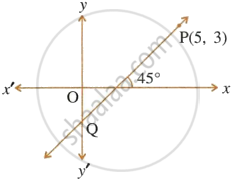Advertisements
Advertisements
प्रश्न
Angles made by the line with the positive direction of X–axis is given. Find the slope of these line.
60°
उत्तर
60°
\[m = \tan60° = \sqrt{3}\]
Thus, slope = \[\sqrt{3}\]
APPEARS IN
संबंधित प्रश्न
(−2, 4), (4, 8), (10, 7) and (11, –5) are the vertices of a quadrilateral. Show that the quadrilateral, obtained on joining the mid-points of its sides, is a parallelogram.
Find the slope and the inclination of the line AB if : A = (−3, −2) and B = (1, 2)
The points (K, 3), (2, −4) and (−K + 1, −2) are collinear. Find K.
The line through P(5, 3) intersects y-axis at Q.
- Write the slope of the line.
- Write the equation of the line.
- Find the co-ordinates of Q.

Lines mx + 3y + 7 = 0 and 5x – ny – 3 = 0 are perpendicular to each other. Find the relation connecting m and n.
Fill in the blank using correct alternative.
A line makes an angle of 30° with the positive direction of X– axis. So the slope of the line is ______.
Determine whether the given point is collinear.
\[P\left( 1, 2 \right), Q\left( 2, \frac{8}{5} \right), R\left( 3, \frac{6}{5} \right)\]
Find the slope of the diagonals of a quadrilateral with vertices A(1, 7), B(6, 3), C(0, –3) and D(–3, 3).
Find the slope of a line, correct of two decimals, whose inclination is 75°
Find the slope of a line passing through the given pair of points (-5,-1) and (-9,-7)
Find the slope of a line passing through the given pair of points (0,5) and (5,0)
Find the slope and the y-intercept of the following line 4y = 5x - 8
Find the slope and the y-intercept of the following line 2x + 3y = 12
Find slope of a line passing through the points A(3, 1) and B(5, 3).
Find the slope of the line passing through the points A(4,7) and B(2,3).
Find the value of x so that the line passing through (3, 4) and (x, 5) makes an angle 135° with positive direction of X-axis.
Show that the line joining (2, – 3) and (- 5, 1) is:
(i) Parallel to line joining (7, -1) and (0, 3).
(ii) Perpendicular to the line joining (4, 5) and (0, -2).
With out Pythagoras theorem, show that A(4, 4), B(3, 5) and C(-1, -1) are the vertices of a right angled.
